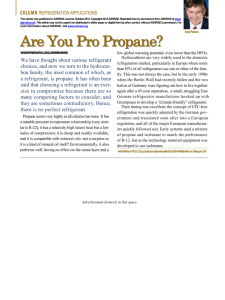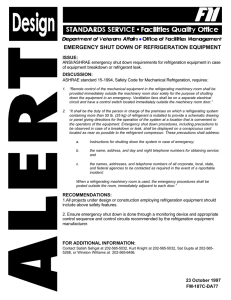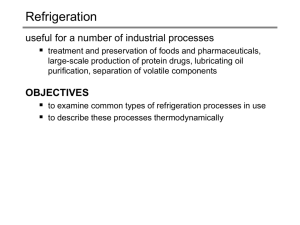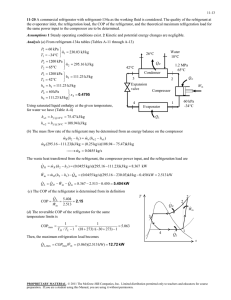Improving the Effectiveness of Air Conditioning and Refrigeration
advertisement
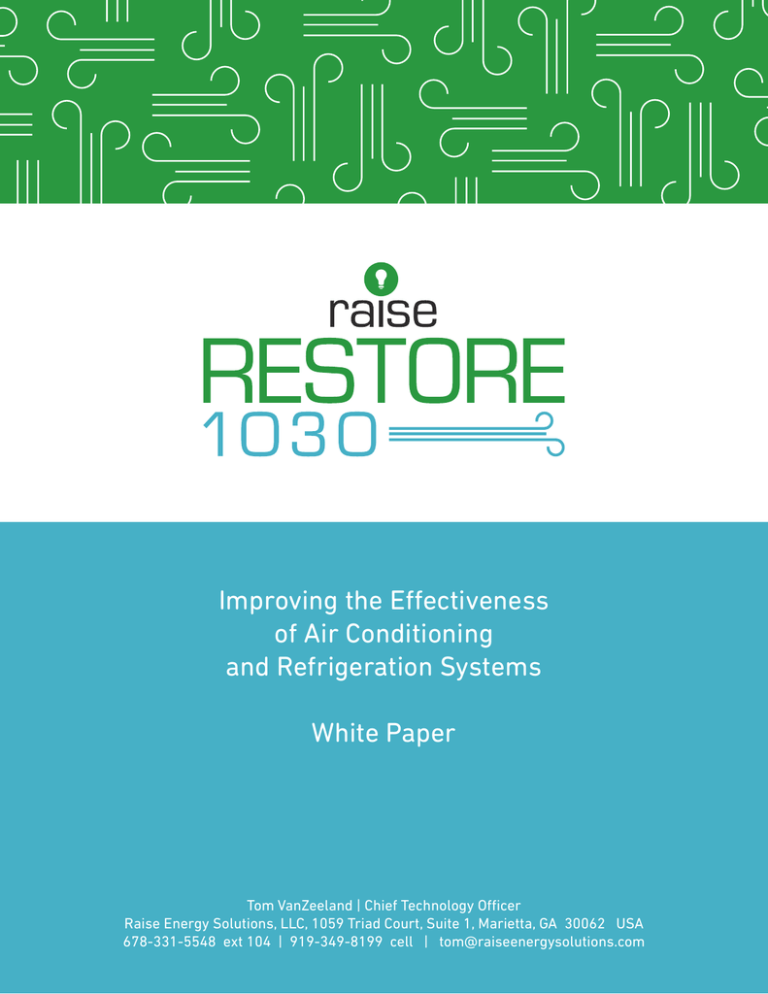
Improving the Effectiveness of Air Conditioning and Refrigeration Systems White Paper Tom VanZeeland | Chief Technology Officer Raise Energy Solutions, LLC, 1059 Triad Court, Suite 1, Marietta, GA 30062 USA 678-331-5548 ext 104 | 919-349-8199 cell | tom@raiseenergysolutions.com Background The search for a solution to decreasing capacity over time in air condition and refrigeration units has been going on for at least the past twenty-five years. The earliest attempts centered on reducing amp draw by reducing friction in the compressor. Some of these attempts were successful in creating short term results particularly in reciprocating compressors. Over time the gains diminished. The American Society of Heating, Refrigeration and Air-Conditioning Engineers (ASHRAE) first published a study in 1986. In the Refrigeration Handbook, published by ASHRAE, it is stated that some lubricating oil is lost from all compressors during normal operation. Since oil inevitably leaves the compressor with the discharge gas, systems using halocarbon (freon) refrigerants must return this oil at the same rate at which it leaves.1 ASHRAE states that unless oil is removed periodically or continuously from the point where it collects, it can cover the heat transfer surface in the evaporator, reducing performance.2 As the oil and refrigerant mix, the chemical composition of both are drastically altered. Pressure and temperature characteristics of this refrigerant/oil mixture will be different from pure refrigerant. In addition, the viscosity of the oil is reduced by dilution with refrigerant, thereby increasing the probability of poor lubrication in the compressor. It matters little whether the refrigerant is miscible or immiscible with the oil. Contaminating oil films are deposited throughout the system, and it is these oil deposits that ultimately cause multiple problems. The result of oil contamination is frequently noticed at the expansion device. Materials dissolved in the refrigerant-lubricant mixture, under liquid line conditions, may precipitate at the lower temperature in the expansion device, resulting in restricted or plugged capillary tubes or sticky expansion valves. A few milligrams of these contaminants can render a system completely inoperative. 3 Any migrating oil in any refrigeration or air conditioning system is costly, both in kWh consumption and money and lost time spent on maintenance and repairs. Oil fouling of the heat transfer surfaces of air conditioning and refrigeration systems, will cause a loss of about 7% efficiency the first year, 5% the second year, and 2% per year the following years. This loss will continue to accumulate until equilibrium is reached between flow force and adhesion. At this point the oil boundary layer formed has achieved its maximum thickness, producing maximum loss of efficiency. Usually, the efficiency degradation will peak somewhere between 20% and 30 %. Published ASHRAE information confirms these observations. According to ASHRAE, performance is degraded by as much as 30% due to the build-up of lubricants on internal surfaces. 4 Higher percentages up to 40% have been observed in systems 20 years old or older. 1 2 3 4 1986 ASHRAE Handbook, Refrigeration, Chap. 3.6 Ibid. Chap. 4.4 1998 ASHRAE Handbook, Refrigeration, Chap. 6.7 “A Survey of Refrigerant Heat Transfer and Pressure Drop Emphasizing Oil Effects and In-Tube Augmentation;” ASHRAE Winter Symposium of 1987; Schlager, Pate, and Bergles. RESTORE1030™ White Paper 1 Approaches to Address the Problem Regardless of the efficiency loss percentages it was quite obvious that removal of “Oil Fouling” presented an opportunity for efficiency improvements. Some of the early attempts contained waxes, sulfur compounds, chlorine and other chemicals that would break down and form acids harmful to the components of the system. Most of these also contained lubricity enhancers in an attempt to reduce friction. They all turned out to offer short term gain and long term pain. The next innovation was the Polarized Refrigerant Oil Additive (PROA) most of the claims stated that “when PROA’s were added to an air conditioning or refrigeration system, its highly polar molecule electrostatically bonds to all metal surfaces displacing the insulative barrier of oil and organic residues with a thermally conductive molecular film, one molecule thick. This film layer prevents re-attachment of oil and other organic contaminants and its highly conductive nature attracts refrigerant to the surface of the coils, accelerating heat transfer and restoring lost efficiency. The restoration of heat transfer results in lower discharge temperatures, shorter compressor run times and less energy to maintain the desired level of cooling or refrigeration.” However, these treatmentsbreak down with normal use, and require constant retreatment. This results in ongoing higher costs. The latest entrant into the field (RESTORE1030™) took a different approach. They used a patent pending dual process to clean the oil fouling and prevent its reforming by using a polymer that chemically bonds to the metal surfaces of the a/c or refrigeration unit. The nature of the polymer is to reduce friction in the compressor and throughout the system, increasing refrigerant flow and lowering the pool boilingtemperature within the evaporator to reduce the evaporator temperature. Evaluation of Approaches The early approaches using cleaners to remove oil-fouling usually created more problems than they solved. The introduction of waxes, soaps, sulfur and chlorine compounds created acids and other compounds that were detrimental to the life of the system. With this type of bond, the long term stability of this solution is doubtful. The RESTORE1030™ approach uses a sequence of events that clean the metal surface of oil fouling and prepares the surface for bonding of a polymer to the surface. This special polymer contains long bonds that are very stable and are not subject to break down under the temperatures and pressures found in a/c and refrigeration systems. The PROA’s relied on Van der Waals forces to electrostatically bond highly polar molecules to the metal surfaces. Van der Waals forces are much weaker than chemical bonds. These bonds are usually broken with random thermal motion and normal refrigerant circulation. RESTORE1030™ White Paper 2 Effectiveness of Solution The comparison here is between the first and second generation PROA’s offered in the market. The comparison claims are from the individual websites and promotional materials of other products in the market. No effort has been made to confirm any of the claims. Comparison of Four Different Products GENERATION PROA A/C RE~NEW RESTORE1030™ FRIGI-TECH ICECOLD MAXR FIRST SECOND FIRST FIRST FIRST X X X X CLEANING AGENT X X ENERGY SAVINGS 5.2 - 10% 10 - 30% ETCHING AGENT (ADHESIVE) X POLYMER X SEAL CONDITIONER METAL BONDING SHORT TERM BONDING X X X Electrostatic Chemical Electrostatic X SUSTAINABLE BONDING ELIMINATON OF OIL FOULING X Electrostatic X X X X X X PREVENTION OF FUTURE OIL FOULING X X FRICTION REDUCTION X X X X X REFRIGERANT EVAPORATION AT LOWER TEMPERATURE X X X X X X (1.96) X X X X COMPATIBLE WITH ALL REFRIGERANTS DECIBEL REDUCTION (dB) X X X X X COMPATIBLE WITH ALL OILS X X X X X UNTESTED X AMMONIA COMPATIBLE CHLORINATED (CHLOROWAX) X NECESSITY OF OIL REMOVAL X ADDED COST OF OIL REMOVAL IN TIME/LABOR X X STANDARDIZED GOVERNMENT TESTING X HAVC LAB ACCREDITED TESTING X IMPROVES SEER RATING X X X X X ? ? ? RESTORE1030™ has Intertek ETL Lab testing on ASHRAE 97 – Sealed Glass Tube Method to Test the Chemical Stability of Material for Use within Refrigeration Systems and Modified SAE J2670 to test for compatibility with seal and O-rings used in refrigeration systems. This testing shows that the product will not damage any of the components. Additional ETL tests (ARI 210/240) on a new operating unit show positive efficiency improvements. There are many other competitive products that do not contain polymers that will show claims similar to Frigi-tec, IceCold and Maxr. RESTORE1030™ White Paper 3 Longevity of Solution There is only one product that can realistically promise a long term solution to “oil-fouling”. That is because only one product uses a polymer bond to prevent future “oil-fouling”. The strength of the polymer bond is sufficient to keep the polymer bonded to the metal surfaces for the life of the unit. All other products are based on van der Waals forces holding polarized particles on the metallic surfaces, which will provide temporary relief from “oil-fouling” at best. Effectiveness of the Solution Removing oil fouling and improving heat transfer is only one aspect of improving efficiency in a/c and refrigeration units. The approach taken by RESTORE1030™ using a patent pending polymer that permanently bonds to all metal surfaces within the system provides benefits other than the removal of oil fouling. Testing by ETL labs on a new 3 ton split unit show the evaporator coil produced 3 degree colder temperatures after the addition of RESTORE1030™. The addition of the polymer allows the annular flow of the refrigerant to occur further into the coil and create colder evaporator temperatures. Refrigerant flow was also increased. Additional benefits of friction reduction occur throughout the system. The molecular structure of the polymer provides friction reduction within the compressor, particularly within reciprocating compressors. There is also friction reduction within scroll and other non-reciprocating units but to a lesser degree since they inherently have less friction by design. This friction reduction shows in the amp draw of the compressor during the first minute of operation. The argument can be made that by increasing the efficiency of the system through use of RESTORE1030™ you will see reduced KWH consumption and increased life of the compressor. RESTORE1030™ White Paper 4
